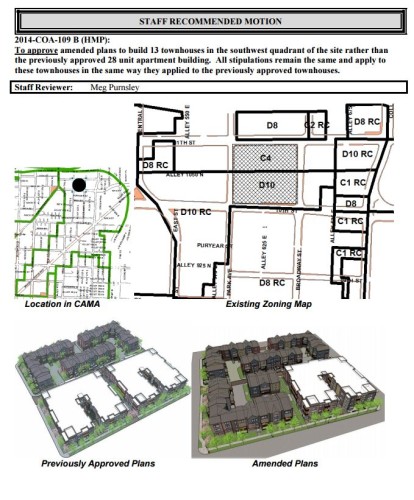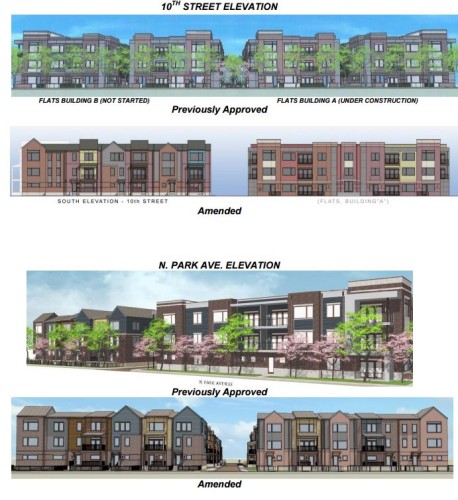In a partial follow-up to a post from April of 2015, Milhaus has applied to switch the final phase of its project at 10th and Park from flats to condominiums. They will match the style on the northern end of the unit:
This is intriguing as it represents fewer units overall for the project. It will go from housing 28 flat-style units to 13 condos. This is mixed news, but it does mean less density in a downtown block.
There does appear to be a new trend downtown for parcels to get more and more valuable that invite mega-large houses or a smaller condo. Further south in Chatham Arch, a long-delayed multi-unit complex was dropped in favor of a large house (bottom story) exceedingly valuable real estate, the corner of East and Walnut Streets. And there are other nearby examples of a move towards exclusivity. This move appears to be supported by the older downtown neighborhoods, especially ones that appear to fear density.
Building a big house (with attached rear garage) on a double lot a block from Mass Ave, and a project moving from smaller flats to larger condos may reveal the maturation of the development cycle downtown. Or it could mean that developers are starting to give up on the inevitable fights about density and giving the neighborhoods what they want to see. It’s an interesting phenomenon to watch. I just hope it doesn’t mean that other downtown developers give up all together and decamp for more fertile territory in the suburbs. Development will happen one way or another, so it might as well be in places that have already been built.



Very sorry to see this happen. The town houses are obviously cheaper to build, and look cheap too. The original building has turned out to be very handsome, but I suspect expensive to build. I live directly across the street, so I am also sorry to see the density decreased. Is this a done deal?
Well done townhouses will look better than any new construction apartment building, density doesn’t equal good design, look at all the huge apartment buildings that have gone up off Mass Ave in the past few years, many of them are dead on the sidewalk storefront.
What are you talking about? Literally the only apt building on Mass that fits your “empty sidewalk” description is the one that isn’t finished yet.
I also am disheartened by the East & Walnut project, but I wouldn’t equate these two exactly. What the 10 Park change says to me is that developers are starting to understand the value of “missing middle” housing types. While this does mean less density than apartments, townhouses like these are the key to keeping young families in the city, as they are in Lincoln Park, parts of Brooklyn or the Upper West Side.
Actually, schools are the key to keeping young families in the city. It has very little to do with housing stock.
Well as a young person about to start a family, I have to agree and disagree. I think its both.
By the way – any idea what happened to the trees from the first rendering?
I wondered that too. Seems like one of the biggest losses to me-
Milhaus confirmed via Twitter that there are still street trees as part of the amended proposal.
It all still looks nice though , and better than nothing there at all, however it would even be nicer to see some taller in that area like 15 story to even something like two twin 18 story mixed use brick and glass type residential(high end apts. , condos, lofts retail etc. , just imagine what that end of the skyline would look like guys haha.
To me, development like this always looks better than some huge apt building that takes up a whole block. People often forget about aesthetics when constantly pushing density.
True. People also forget about social cost. It would be a fascinating case study to see if cities that have replaced mega dense public housing (like Cabrini Green and Robert Taylor Homes)with something more reasonable have seen gains as a result. It would also be interesting to see how much density played into the failure of those social experiments. It’s great to imagine a more urban city, but the new urban model is quite a bit different than what Upton Sinclair wrote about and thank God for that.
Organic density and public housing density are very different things. This is not public housing.
I agree, a city like Paris is mostly made up of 7 story mixed use buildings and is a very dense city. I used to want all of our cities to build more and more skyscrapers like Chicago or NYC, but now I believe that a place that focuses on buildings like Paris is a much more livable place. The scale of Paris’ streets to buildings are just all just about right.
Indy needs to focus on quality infill projects and improving the public infrastructure while maintaining it. That combined with really good urban schools and Indy will be a very livable place for all age groups.
4 story for this area would have been appropriate
flats aren’t selling right now. town-homes are…
Couldn’t all of this be spot zoning? New Urbanists talk about housing transitions and missing middle housing but the question shouldn’t be JUST single family or multifamily, there’s an array of housing types not being built that would be a win for city hall and developers yet still a compromise on density concerns.
I’ve often wondered that myself, Eric. Not being from here, I write it off as a peculiar Midwestern (black or white) thing. I think it’s easy to lash out at developers (not saying you’re doing that, just a general comment about the board) but they know their market far better than hobby urbanists do. They’re delivering what the market will pay to consume. There’s a reason Indy isn’t dense. It has to do with land and zoning and utility availability and all that, but it also has to do with local taste. We’re a minority here, like it or not.
I agree with you Michel. I’ve come to a similar realization. This is not a local culture where the vast majority of people values good urbanism. A lot of people, even younger people, still aspire to buy a house and have a backyard. I do think it’s starting to change a bit in that many people are starting to wake up to and desire being able to walk to things. Everyone having their own yard and driveway in residential-only neighborhoods does not make for a walkable place.
I am confused as to the meaning of “flat” as used in this development. Historically (in England) a flat was a rental apartment. The developer’s marketing refers to a mix of flats, condominiums, and townhomes – none of which appear to be rental units.